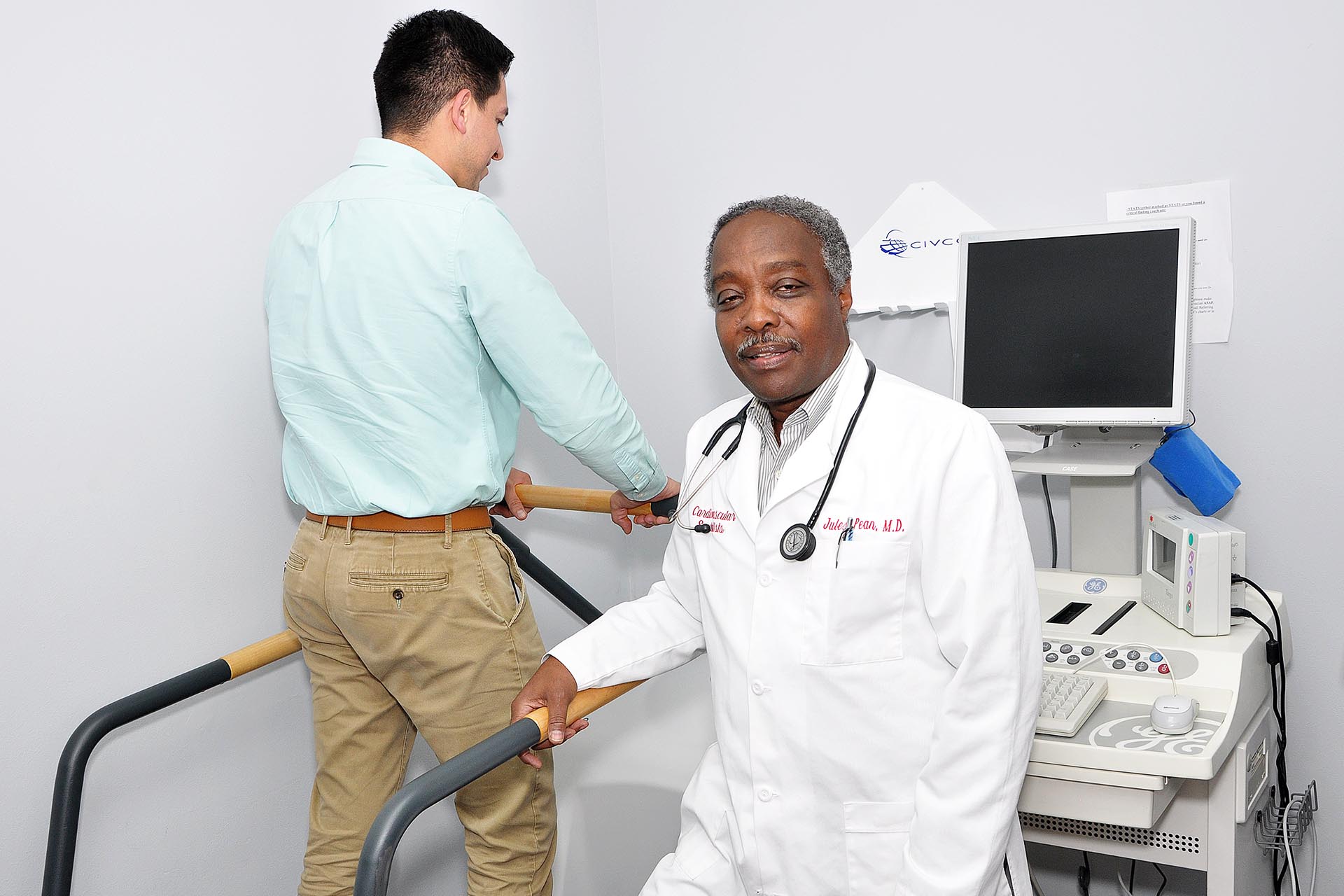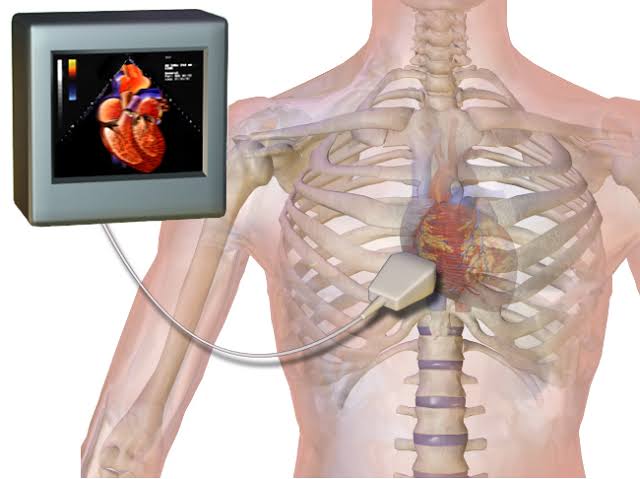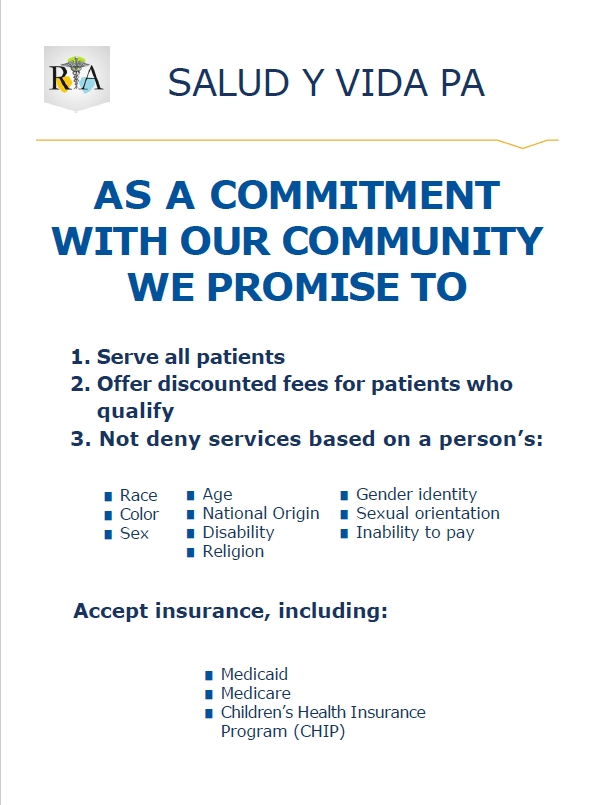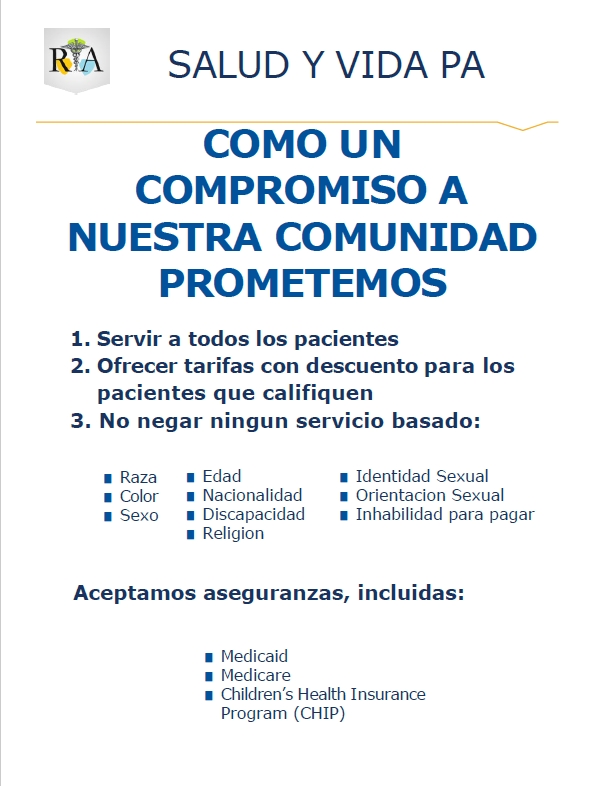CARDIOLOGY


-
Testing
Each of our diagnostic tests may require certain preparations. Your doctor will inform you of these preparations when your test is scheduled. For all tests below (except for blood tests) we ask all patients to wear loose, comfortable clothing to their test and avoid wearing cologne, perfume or jewelry. For all tests below, please take your usual medications unless instructed otherwise by your physician. DO NOT DISCONTINUE any medication without first talking with your physician.FOR ALL STRESS TESTS (Exercise stress echo, exercise stress test): Do not have anything to eat or drink for three hours before the study). Wear or bring comfortable clothing and rubber-soled shoes.


-
AMBULATORY BLOOD PRESSURE MONITOR
24-hour Ambulatory Blood Pressure Monitoring (ABPM) allows your physician to review your blood pressure range for 24 (or occasionally 48) hours. Your physician may recommend this type of testing whenever there is a question of whether your blood pressure might only be elevated at the doctor’s office (“white-coat hypertension”) or if there is a question of response to blood pressure medications.In addition to the monitor, patients will be given a diary to monitor their symptoms or activity that the doctor can use to correlate with potentially very high or low blood pressures. Allow 30 minutes for hook-up in our office with explanation of its use. Patients need to return to the office approximately 24 hours later to return the device. The blood pressure measurements are then analyzed by the physician.ABPM is thought of as more accurate than office measurements and home monitoring by patients with their own cuff. It can be useful not only for confirming whether hypertension is present or not but also in assistance in hypertension management. ABPM can be used to document the presence of “white-coat” or masked hypertension, resistant and labile hypertension. In addition, ABPM can identify whether a patient is a “dipper” (ABP decreases > 10% during sleep) or nondipper. This distinction is important, as nondipping status has been linked to increased risk for cardiovascular events and end-organ damage.AMBULATORY BLOOD PRESSURE MONITORING INFORMATIONAmbulatory blood pressure monitoring is a test that measures blood pressure over a period of 24 hours while people perform their normal daily activities. The patient wears a small monitor that takes readings every 15 to 30 minutes and saves them in the memory. lt provides accurate and reliable information and can give the doctor a more precise overview than the occasional readings that are taken in the doctor's office.Wearing a monitor does not interfere with most daily activities. While you can remove it to take a bath or shower, we prefer that our patients do not do this as often when the device is put back on it does not get as accurate of a reading of blood pressures.The monitors are light, easy to use and silent. ln the doctor's office, a trained professional will program the device for it to automatically measure blood pressure throughout the day and night. You will wear an inflatable cuff on one arm and a recording device of the size of a "cellphone" on the waist. Most people do not find this uncomfortable.After 24 hours, the monitor is removed and it is given to the doctor. The blood pressure readings are retrieved from the monitor, and the doctor can use this information to evaluate whether the blood pressure is well controlled and adjust the treatment if necessary.

-
ATHEROSCLEROSIS SCREENING ULTRASOUND
Carotid ultrasound allows your physician to find the earliest signs of plaque buildup in arteries (atherosclerosis). Atherosclerosis is the process that ultimately can lead to heart attacks and strokes. Using an easy, quick and painless ultrasound technique, the earliest signs of hidden plaque buildup (first seen as increased thickness of the artery wall) can be recognized. Much more sensitive than regular carotid ultrasound vascular imaging, this special technique, Carotid US, has been shown to correlate with future risk of stroke and heart attack.Unlike CAT scans of the heart, there is no radiation exposure and testing takes just a matter of minutes. Results of the carotid ultrasound imaging study are available soon thereafter.“You are as old as your arteries.”– Attributed to Physician Sir William Osler (known as the “father of modern medicine”), early 20th century.

-
ECHOCARDIOGRAM (ECHO)
Echocardiography (commonly known as an echo) is a technique that uses sound waves to create images of the heart. These images allow physicians to assess the valves of the heart, as well as the size and function of the chambers. This test is performed by moving a transducer across the chest to produce images of the chambers and valves within the heart. Your doctor may ask you to undergo an echo in order for the cardiologist to:• Assess the overall function and size of your heart.• Determine the presence of heart disease.• Follow the progress of valve disease or heart failure over time.• Evaluate the effectiveness of medical or surgical treatments.This test requires you to lie on your left side (and briefly on your back as well) for approximately 30 – 45 minutes although you should plan on spending at least one hour from your arrival at the office until you leave.
- EXERCISE STRESS ECHO
- IN ORDER TO PREPARE FOR A STRESS ECHO TEST:
- CONSENT FOR TREADMILL STRESS TEST

-
ELECTROCARDIOGRAM (ECG OR EKG)
During an electrocardiogram, electrodes are placed on your upper body and legs to obtain an “electrical image” of the heart. This routine non-invasive test evaluates the heart rhythm, determines whether the electrical system of the heart is functioning properly and whether parts of the heart might be enlarged or damaged. This test generally takes less than 5 minutes.There are several reasons for your doctor to recommend an ECG, some of which may include:• To determine the cause of chest pain, palpitations, dizziness or shortness of breath• To make sure the blood is receiving adequate blood flow• To ensure that the heart is strong enough to withstand surgery• To see if the heart is enlarged for patients with a history of high blood pressureELECTROCARDIOGRAM (ECG or EKG)Small sticky pads (electrodes) are placed on your upper body and legs to obtain an “electrical picture” of the heart. It is printed out on a special graph paper for the cardiologist to interpret. This common, routine and frequently used non-invasive test tells the doctors about your heart rhythm (how fast and regular it beats), and whether the electrical system of the heart (kind of like biological electrical wiring) is working ok, and indirectly whether parts of the heart might be enlarged or damaged.This test generally takes less than 5 minutes.Reasons your doctor may want to perform this testThere are several reasons for your doctor to recommend an ECG and some of them include:• If you have chest pains or angina, an ECG provides valuable information as to why you may be experiencing chest pain.• If you have had a history of blockages in your coronary arteries, a history of a heart attack or risk factors for developing these blockages, an ECG can help the doctor see if you heart is getting adequate blood flow or has suffered damage in the past.• If you are about to undergo surgery, an ECG can help the doctor see if your heart is strong enough to withstand the stress of a long and/or complicated medical procedure.• If you have had palpitations (the sensation of your heart beating rapidly or irregularly) or dizziness, an ECG can help the doctor see why you might be having these symptoms.• If you have a history of hypertension (elevated blood pressure), an ECG can help the doctor determine if your heart might be enlarged.• If you have shortness of breath, an ECG can help the doctor determine if your heart might be the cause.HOW TO PREPARE FOR THE STUDYNo preparation is necessary although avoiding applying excessive skin lotions or body oil to the torso and legs can help make sure the results are accurate.Please take your usual medications unless instructed by your physician.NOTE: Do not discontinue any medication without first talking with your physician.

-
EVENT MONITOR (EVENT RECORDER)
Event Monitoring is a painless way to record your heartbeat away from the doctor’s office.An event monitor (also sometimes referred to as an event recorder) is a small limited electrocardiogram (ECG) that you wear or carry with you to record irregular heartbeats, which are reviewed by your doctor at a later time. There are two main types: 1) a “non-looping” recorder which is essentially a small “card” and can be carried in a purse or pant pocket and put over the heart while pressing a button when symptoms occur, or; 2) a “memory-loop” recorder which is worn at all times (and is always recording) for several weeks where patients can simply press a button during or after they experience symptoms. You will usually carry these monitors for two to four weeks and which type of device you are given depends on your symptoms and will be decided by your doctor.Your physician may recommend an event recorder whenever you experience symptoms like dizziness, palpitations, skipped beats or other sensations which may occur during normal day to day activities, but not necessarily while you’re in the physician’s office or on a daily basis. Allow 15 – 30 minutes for hook-up in our office with explanation of its use.EVENT MONITORYou will be given a small “card,” plastic “wrist watch,” or a small cassette-type recorder with wires and electrodes hooked onto your body to wear for up to 30 days. This will allow you to transmit a recording of your heart rhythm during specific symptoms. Allow 30 minutes for hook-up in our office with explanation of its use.Event Monitoring is a painless way to record your heartbeat away from the doctor's office. An event monitor is a small limited electrocardiogram (ECG) that you carry with you. It records your heartbeat for your doctor to review at a later time. The event monitor lets you record your irregular heartbeat as you feel it. You simply press a button. Our staff will show you how to use it and then how to transmit the recording over a land-phone line. You will usually carry this monitor for two to four weeks. Your physician may recommend this type of testing whenever you experience symptoms like dizziness, palpitations, skipped beats or other sensations which may occur during normal day to day activities but not necessarily while you're in the physician's office.If you have fainted in the past, or if your doctor thinks you might have heart rhythm irregularities that you are not aware of, you will have a type of monitor that actually hooks up to your body. The latter type of device is continually recording your heart rhythm with several minutes of memory so that an irregularity of the heart rhythm can be recorded after the fact (these are referred to as “memory-loop” recorders). Instructions on how to change electrodes (sticky pads on your skin that connect to flexible wires which connect to the actual recorder) every several days will be given by our staff.Your Event MonitorAfter you are shown how to use your event monitor, carry it with you all the time. When you feel a symptom, activate the monitor by pressing a button (wristwatch style) or holding it to your chest (small box or credit card style). Be sure to keep a diary.When Using a MonitorPlease stay away from electric blankets, magnets, metal detectors, and high-voltage areas such as power lines. They may affect the recording.When phoning in your recording:• Tell the technician on the phone, the date and time for each recording you make (when symptoms occurred).• Note any symptoms you feel and what you are doing at that time.Accurate, concise information is important!Important Things to Remember• Do not take a bath, shower or swim while carrying or wearing it.• Keep pressing the button until several seconds after your symptoms resolve.• Try to get to a land phone line to phone in the recording as soon as possible after pushing the button• Do not remove the tape or battery from inside the monitor.

-
EXERCISE STRESS ECHO
An exercise stress echocardiogram produces images of the heart while the patient is at rest and during exercise in order to determine the size and function of the heart, including its chambers and valves. The test is used to:• Determine how well your heart tolerates activity and your level of fitness• Evaluate the function of your heart and valves• Determine your likelihood of having coronary artery disease (blocked arteries)• Evaluate the effectiveness of your cardiac treatment plan.
- WHAT HAPPENS DURING THE TEST?
- EXERCISE STRESS ECHO
- IN ORDER TO PREPARE FOR A STRESS ECHO TEST:
- CONSENT FOR TREADMILL STRESS TEST

-
HOLTER MONITOR
24-hour Ambulatory ECG (Electrocardiographic) Monitoring (Holter) allows your physician to review your heart’s activity for 24 hours. Your physician may recommend this type of testing whenever you experience symptoms such as dizziness, palpitations, skipped beats or other sensations which may occur during normal day to day activities, but not necessarily while you’re in the physician’s office.In addition to the monitor, patients will be given a diary to monitor their symptoms that the doctor can use to correlate with irregularities within the heart. Allow 30 minutes for hook-up in our office with explanation of its use. Patients need to return to the office approximately 24 hours later to have the device removed.HOLTER MONITORYou will be hooked up to a “mini” EKG system and recorder which are strapped to a belt. Allow 30 minutes for hook-up in our office with explanation of its use. You will need to return approximately 24 hours later (thus this test will not be scheduled on Fridays) to our office to be disconnected, which should take less than 15 minutes.What should I wear the day of the test?Please dress in loose, comfortable two-piece clothing. NO body lotion on your chest the day of your exam.24- hour ambulatory electrocardiographic (Holter) Monitoring allows your physician to review your heart's activity for 24 hours. It allows the physician to look at each individual heartbeat.Your physician may recommend this type of testing whenever you experience symptoms like dizziness, palpitations, skipped beats or other sensations which may occur during normal day to day activities but not necessarily while you're in the physician's office.• The monitor itself is the size of a large portable cassette recorder. Your heartbeat is actually recorded on a cassette inside.• EKG patches and wires will be applied to your chest, and secured with tape by the technicians or nurses in our office.• You will wear this monitor for a 24 hour period. We want you to continue your normal daily activities.• You will be given a diary to note if you have any symptoms. You should note the time on the Holter recording device and also push the event button in addition to noting the symptom(s) in the diary so the doctor can subsequently correlate you symptoms with any irregularity of the heart.When you receive a Holter monitor, small, painless sticky pads (electrodes) are put on your chest. These connect to the lightweight unit, which attaches to a belt or shoulder strap. You need to keep the device on for at least 24 hours and complete a diary. While wearing the monitor, follow these tips:• Try to sleep on your back.• Don’t take a shower. A sponge bath is OK.• Follow your normal routine. Don't avoid stress, work, or exercise. Obviously, you cannot swim while wearing the device.• If an electrode falls off or the unit makes noise, call to see what you should do.Please stay away from electric blankets, magnets, metal detectors, and high-voltage areas such as power lines. They may affect the recording.Holter Monitor Diary EntriesA diary will be given to you when you are connected to the Holter Monitor. You will need to carry the diary with you while you are wearing the monitor.Your diary is an important tool used by both the technical staff processing your report, and to the physician who will be interpreting the study. Your diary could correlate the symptoms you have been describing to your physician with changes in your heart's rhythm.In the diary:• Write in the time of day (based on the clock on the Holter device) for each entry you make;• Note any symptoms you feel;• Note any significant change in your activity (such as exercising). Accurate, concise diary entries are important!Important Things to Remember• Do not take a bath, shower or swim while wearing it.• Do not take the monitor off until the time you are instructed to do so.• Do not remove the tape or battery from inside the monitor.
Email Newsletters:
- Email: info@saludyvidapa.com

